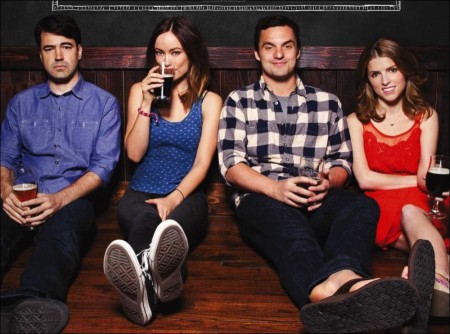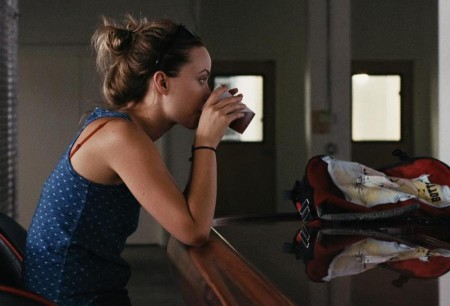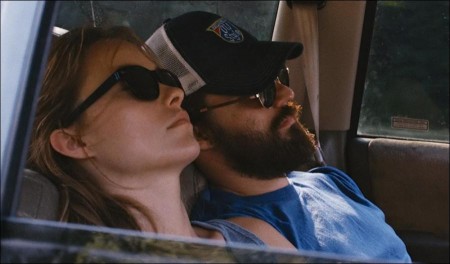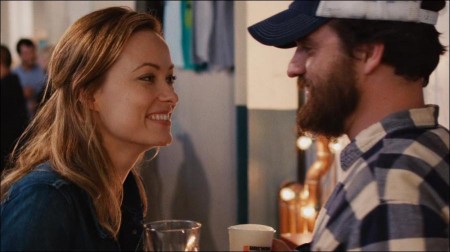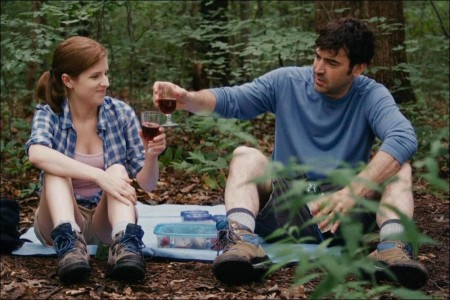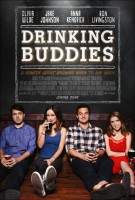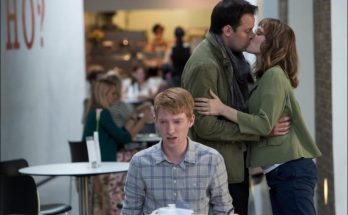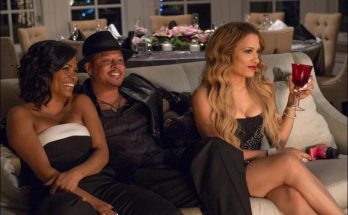Kate (Olivia Wilde) and Luke (Jake Johnson) work together at a craft brewery. They have one of those friendships that feels like it could be something more. But Kate is with Chris (Ron Livingston), and Luke is with Jill (Anna Kendrick). And Jill wants to know if Luke is ready to talk about marriage. The answer to that question becomes crystal clear when Luke and Kate unexpectedly find themselves alone for a weekend. Drinking Buddies is written and directed by Joe Swanberg and stars Olivia Wilde, Jake Johnson, Anna Kendrick, and Ron Livingston.
Drinking Buddies is an American film written and directed by Joe Swanberg, and starring Olivia Wilde, Jake Johnson, Anna Kendrick and Ron Livingston. The film is about two co-workers at a craft brewery in Chicago. The film premiered at the 2013 South by Southwest Film Festival, and also screened within Maryland Film Festival 2013.
Q & A with Director Joe Swanberg (2013)
What was the inspiration for this project?
The inspiration originally came from two places: The first was studio comedies of the early 1970’s, specifically BOB & CAROL & TED & ALICE and Elaine May’s THE HEARTBREAK KID, which were both mainstream films (and big hits!) that portrayed complicated, interesting characters and adult points-of-view. The most important lesson I took from these films is that they never forgot to be funny, which earned them the space to also be complex and challenging.
The second inspiration was the craft beer world. Craft beer is the most exciting business in America right now, if you ask me, and I wanted to get inside a world that I love. I’m a home brewer and a craft beer advocate, and as the years passed, I realized that nobody was making a movie about it.
I started talking to a friend of mine, Kate Thomas, who works for Half Acre Brewing in Chicago. She told me about her job, and about being a woman in a very male dominated industry. Through her stories, and other conversations with friends who work at breweries, I started to form the Kate character, who has learned to thrive in her surroundings. The other main character, Luke, and his girlfriend, Jill, are modeled after my wife and I at a certain point in our relationship before we were married, when we were still trying to figure things out.
As with all of my films, once I had the cast in place we started to work on the characters and the story together. Olivia had great ideas about Kate, and brought a lot of her own life to it. Jake Johnson and Anna Kendrick shared their own relationship experiences with me so that we could blend them with mine to make Luke and Jill as relatable as possible. Once we all started talking about these issues, we realized how universal they are. Everyone struggles to balance relationships and platonic friendships with the opposite sex. Everyone has doubts and questions about whether they’re with the right person, or whether they could be happier with someone else. We had fun throughout the shoot talking about these subjects and working our ideas into the film.
How do you write your films?
I start with a few broad subjects or themes that I’m interested in and I work with my collaborators to generate specific ideas. This usually happens through phone calls and emails, in a very casual way, as opposed to writing sessions with a specific goal in mind. As certain ideas start to solidify, I will create an outline to give the film some shape. These outlines are usually a page or two long with a short paragraph describing my idea of the scene. I typically go into production with only the outline to work from, and the writing process continues on set with the actors. As we film a scene, we are writing and rewriting with each take, and also writing the next day’s scenes based on how the current day is going.
With Drinking Buddies, I needed a way to communicate with the art, wardrobe and locations departments, so I took my outline and expanded it into something much closer to a traditional script. It was mostly free of dialogue, but it conveyed in great detail the scenes in the film, where they took place, what the locations looked like, and what the actions were. This allowed us to schedule the film and incorporate the entire infrastructure without sacrificing the freedom for the actors and I to figure certain things out in the moment.
The first take of any scene I do is usually the “writing” take. Occasionally we get exactly what I’m hoping for and we only do something once, but typically we use the first take to shape the scene, keeping certain things and making adjustments to other things. The dialogue is always improvised, and there are variations from take to take, but we’re working toward a unified version of the scene that feels right. Once we have something we like, we go from there.
With this film, for the first time, you worked using a more traditional production infrastructure – how did this affect the way you made the film and why did you do this?
I wanted to tell a story about these characters, and the craft beer world, and the film naturally evolved into being the size it is. There wasn’t a concerted effort to make something “BIGGER.” We just looked at the locations we needed, the kind of crew we needed, and I pursued the actors I wanted to work with, and everything else fell into place accordingly. The size of the film is exactly what it needed to be to tell the story in the way I wanted to tell it.
The additional infrastructure required me to make many decisions during pre-production that I usually make on the day of shooting. I wanted to give my collaborators in the art, wardrobe and location departments plenty of time to do their best work, and that meant arriving at some definitive answers to big questions very early in the process. Rather than fighting the system and trying to bring the entire Hollywood production model to me, I happily embraced this new way of working and focused on carving out space for the actors and I to work out the emotional details on set. Rather than focusing on the restrictive elements of the infrastructure, I focused on my new freedom to be a director and a director only, as smart, talented, hard-working people took over most of the jobs that I had previously handled myself.
Despite the much larger crew, we still had to be able to break down and be flexible when necessary. Our main location in the film is a brewery and they were busy making beer every day that we were there. We had to be sure that we were never in their way. The brewers were suspicious of us at first, and seemed a bit territorial, but the head brewer, Jim Cibak, took Jake under his wing and taught all of us a lot about making beer. All of the employees at the brewery have cameos in the film and many times I would see them sitting at the monitor watching takes or talking to the actors and crew about filmmaking. It felt like a cultural exchange in the best way!
One thing I loved about my smaller productions, that I was fearful of losing, was the sense of fun and the spirit of togetherness. So at the first production meeting I gave a speech and declared a Fun Mandate for the film. I was sure to point out that “fun” did not mean “easy.” We were all going to be working very hard, make no mistake, but that didn’t mean we couldn’t have fun while doing it. I strongly believe that a fun film set produces better work from all involved and ultimately a better film. Thankfully there was a great team working on the film and it was the most enjoyable filmmaking experience I’ve had.
How did you work with the actors?
Working with actors remains the most inspiring part of the filmmaking process for me, and Drinking Buddies allowed me to devote most of my energy to this. was lucky to have a few days with Olivia and Jake before we started shooting, and I used this time to familiarize them with the Chicago craft beer world. We brewed beer together in my basement, so they could see how it’s made, and then we took a trip to the Three Floyd’s brewery, where my friend Andrew Mason, who brews there, showed them around. I knew I wasn’t going to turn either of them into beer experts in 2 days, but I wanted them to soak up the atmosphere and get a sense of the people who work in a brewery. During this beer boot camp, we were also discussing the characters and the story and finding ways to plug Olivia and Jake’s experiences into the story.
We scheduled the film in such a way that Olivia and Jake would have a week of shooting together before Anna and Ron got to town. I wanted to give them space to play and figure some things out before we got into the meat of the story. We worked quickly the first few days, doing small, playful scenes, and then moved toward more dramatic moments. They quickly found a rhythm with each other and started to add to the story and the characters with each scene.
When Anna and Ron arrived, we had to work on the fly, building the relationships and the character dynamics while we were shooting. This is how I’m used to working, so I felt right at home. Everything was made easier by the fact that these actors are incredibly good at what they do, and things like continuity are second nature to them. So despite the improvisation, and looseness of the dialogue, the actors could always hit their marks and keep certain actions consistent in a way that made editing very easy.
In the middle of the shoot we spent 3 days filming at a beachfront cabin in Michigan, and this was the perfect way to decompress while also getting work done. After we would wrap for the day, the cast and crew would go swimming and build bonfires on the beach. It was during this period that I got to know the actors the best, and we moved into the second half of the shoot with a great level of trust and camaraderie between everyone working on the film.
Cast Q & A
Why did you want to work with Joe Swanberg and how did you like making the film?
Olivia Wilde
I wanted to work with Joe after seeing HANNAH TAKES THE STAIRS and hearing fantastic things about him as a collaborator. I wanted to experiment with his unusual process of making a film (improvising the entire script) and dive into the unknown with only an open mind. I loved my first few conversations with Joe about the characters and we really just seemed to get along and jive immediately. His idea for the story was immediately intriguing.
I loved making this film. I felt inspired on an entirely new level. We were set free and dared to be honest. Joe is brilliant, because he allows the actors to feel safe while letting go of their typical process, and he is a master editor. I can’t wait to make another film with him.
Jake Johnson
I wanted to work with Joe because Joe is all about freedom. He told me when pitching the idea to me that whatever I was feeling each day would be what my character was feeling. He wants his movies to be a true collaboration. I found him to be true to his word and a true honor to work with him.
Anna Kendrick
I was excited about the idea of working with Joe because of this gorgeous honesty in his films and was equally excited by our brief and awkward first meeting over Skype where even then I got my first glimpse of his intelligence and confidence; I knew that he was someone whose instincts I could trust completely.
Signing onto the film was terrifying and I was sure I was going to end up the weakest link but the environment when I arrived was so relaxed and supportive. It was a really freeing experience. Everyone in the cast was so talented and open and on top of that you always had Joe as your safety net. You felt like you could be really brave.
Ron Livingston
I love Joe’s confidence in his storytelling. He really works without a net, and invites you to work that way, too, and it’s exhilarating. You get the feeling from him that he can make a movie out of whatever you give him, which allows you the freedom to give him whatever you want. Say what you want, do what you want, change it up every take (which is maybe two) — it’s a hell of a way to make a movie. What’s unfathomable to me is that it seems to work. Which means that those of us taking years and spending millions of dollars to make movies have a lot of explaining to do.
Drinking Buddies (2013)
Directed by: Joe Swanberg
Starring: Olivia Wilde, Jake Johnson, Anna Kendrick, Ron Livingston, Ti West, Mike Brune, Michael Gaertner, Kristin Davis, Alicia Van Couvering, Joe Swanberg, Michael Zeller
Screenplay by: Joe Swanberg
Production Design by: Brandon Tonner-Connolly
Cinematography by: Ben Richardson
Film Editing by: Joe Swanberg
Costume Design by: Amanda Ford
Set Decoration by: Jennifer Herrig
Art Direction by: Akin McKenzie
MPAA Rating: R for language throughout.
Studio: Magnolia Pictures
Release Date: August 23, 2013
Visits: 78
